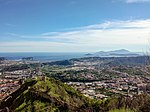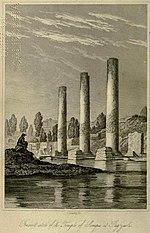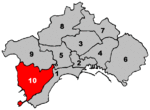Solfatara (volcano)

Solfatara (Italian: Solfatara di Pozzuoli) is a shallow volcanic crater at Pozzuoli, near Naples, part of the Phlegraean Fields (Italian: Campi Flegrei) volcanic area. It is a dormant volcano, which still emits jets of steam with sulfurous fumes. The name comes from the Latin, Sulpha terra, "land of sulfur", or "sulfur earth". It was formed around 4000 years ago and last erupted in 1198 with what was probably a phreatic eruption – an explosive steam-driven eruption caused when groundwater interacts with magma. The crater floor was a popular tourist attraction until 2017, as it has many fumaroles and mud pools. The area is well known for its bradyseism. The vapours had been used for medical purposes since Roman times. This volcano is where the thermoacidophilic archaeon Sulfolobus solfataricus was first isolated. The archaeon is named for the volcano, as most species of the genus Sulfolobus are named for the area where they are first isolated. In 305, this is the location where the patron of Pozzuoli, Saint Proculus, and the patron of Naples, Saint Januarius were beheaded. In 2017, three people—an 11-year-old boy and his parents—died, when they fell into a chasm. Initial rumors that claimed that the boy had entered an off-limits area of the crater were declared false by an eyewitness who had watched the scene unfold from her balcony. According to the eyewitness, the family were on the official walking path, when the 11-year-old slipped into the unsecured chasm. His parents died in an attempt to save him. The only survivor was the boy's 7-year-old brother.
Excerpt from the Wikipedia article Solfatara (volcano) (License: CC BY-SA 3.0, Authors, Images).Solfatara (volcano)
Via Coste d'Agnano,
Geographical coordinates (GPS) Address External links Nearby Places Show on map
Geographical coordinates (GPS)
| Latitude | Longitude |
|---|---|
| N 40.827 ° | E 14.139 ° |
Address
Vulcano Solfatara
Via Coste d'Agnano
80078 , Rione La Solfatara
Campania, Italy
Open on Google Maps










